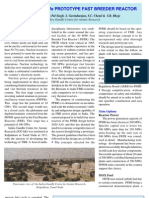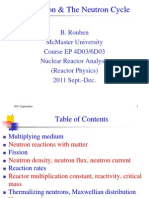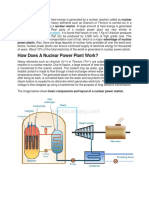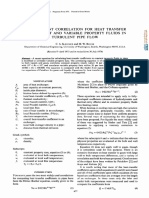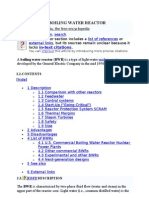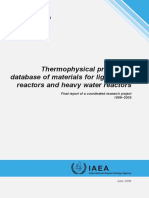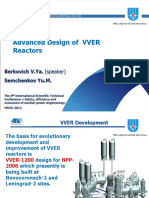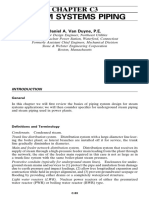0 ratings0% found this document useful (0 votes)
84 viewsNuclear Fuel Cycles
Nuclear Fuel Cycles
Uploaded by
Dil SomThis document discusses advanced nuclear fuel cycles and synergistic relationships between different fuel cycle options. It presents arguments for and against nuclear power that are tied to the fuel cycle. One approach discussed is using new reactor designs like fast breeder reactors to minimize waste and produce more energy from uranium by breeding plutonium. Modeling shows that a phase-in of a combined light water and fast breeder reactor system could reduce plutonium stockpiles and spent fuel over time.
Copyright:
© All Rights Reserved
Available Formats
Download as PPTX, PDF, TXT or read online from Scribd
Nuclear Fuel Cycles
Nuclear Fuel Cycles
Uploaded by
Dil Som0 ratings0% found this document useful (0 votes)
84 views15 pagesThis document discusses advanced nuclear fuel cycles and synergistic relationships between different fuel cycle options. It presents arguments for and against nuclear power that are tied to the fuel cycle. One approach discussed is using new reactor designs like fast breeder reactors to minimize waste and produce more energy from uranium by breeding plutonium. Modeling shows that a phase-in of a combined light water and fast breeder reactor system could reduce plutonium stockpiles and spent fuel over time.
Original Title
nuclear_fuel_cycles.ppt
Copyright
© © All Rights Reserved
Available Formats
PPTX, PDF, TXT or read online from Scribd
Share this document
Did you find this document useful?
Is this content inappropriate?
This document discusses advanced nuclear fuel cycles and synergistic relationships between different fuel cycle options. It presents arguments for and against nuclear power that are tied to the fuel cycle. One approach discussed is using new reactor designs like fast breeder reactors to minimize waste and produce more energy from uranium by breeding plutonium. Modeling shows that a phase-in of a combined light water and fast breeder reactor system could reduce plutonium stockpiles and spent fuel over time.
Copyright:
© All Rights Reserved
Available Formats
Download as PPTX, PDF, TXT or read online from Scribd
Download as pptx, pdf, or txt
0 ratings0% found this document useful (0 votes)
84 views15 pagesNuclear Fuel Cycles
Nuclear Fuel Cycles
Uploaded by
Dil SomThis document discusses advanced nuclear fuel cycles and synergistic relationships between different fuel cycle options. It presents arguments for and against nuclear power that are tied to the fuel cycle. One approach discussed is using new reactor designs like fast breeder reactors to minimize waste and produce more energy from uranium by breeding plutonium. Modeling shows that a phase-in of a combined light water and fast breeder reactor system could reduce plutonium stockpiles and spent fuel over time.
Copyright:
© All Rights Reserved
Available Formats
Download as PPTX, PDF, TXT or read online from Scribd
Download as pptx, pdf, or txt
You are on page 1of 15
At a glance
Powered by AI
The presentation discusses advanced nuclear fuel cycles and synergistic relationships between different types of reactors and fuel cycles. It also covers topics like breeder reactors and modeling a phase-in of fast breeder reactors.
Arguments for nuclear power include reducing carbon emissions and producing more energy from the fuel. Arguments against include the lack of a long-term waste storage solution and safety/proliferation concerns.
A breeder reactor produces more fuel than it consumes by using uranium-238 in a breeding blanket to produce plutonium that can be used as fuel. It requires a fast neutron spectrum to achieve this breeding process.
Synergistic Relationships of
Advanced Nuclear Fuel Cycles
Jordan Weaver
Technology Report Presentation
Obligatory Graphic of Fuel Cycle
Uranium Mining,
Milling, Refining
Ore Tailings
Yellowcake
(U
3
O
8
)
Conversion
UF
6
(gas)
Enrichment
Depleted
Uranium
Enriched
UO
2
Fuel
Fabrication
Fuel
Assemblies
Reactor
e
-
Irradiated
Fuel
Onsite Cooling
Storage
Transportation
Reprocessing
Disposal
Pu and
(maybe)
other
actinides
High
Level
Waste
(HLW)
Vitrification
Vitrified
HLW
Fuel Cycles are a Hot Topic Right Now. Why?
If new reactor designs prove as safe as hoped and if progress is made on waste disposal,
proliferation prevention, and protection against terrorism, nuclear power will deserve a
chance to compete in the market against other sources of power that do not emit CO
2
. -
Boston Globe, June 16, 2005
Now that the United States has removed the ban on recycling used fuel, it will be possible
to use that energy and to greatly reduce the amount of waste that needs treatment and
disposal. Last month, Japan joined France, Britain and Russia in the nuclear-fuel-recycling
business. The United States will not be far behind - Patrick Moore, Greenpeace Founder,
in the Washington Post, April 16, 2006
But there are arguments [against nuclear power] that do stand up. The most fundamental
environmental principle is that you don't make a new mess until you have cleared up
the old one. To start building a new generation of nuclear power stations before we know
what to do with the waste produced by existing plants is grotesquely irresponsible. The
government's advisers have determined only that it should be buried. No one yet knows
where, how or at what cost. - The Manchester Guardian [UK], July 11, 2006
Consider these arguments for and against nuclear power --
--- The concerns raised are inevitably tied up with the fuel cycle.
Motivation
One possible aspect of an advanced fuel cycle
lies in the use of new reactor designs that will
help to minimize the amount of waste that
will be disposed of as well as produce more
energy (and more fuel).
Generic Sodium-Cooled Fast Reactor
Fast Reactor Physics
Typical PWR Neutron Flux Fast Na-Cooled Reactor Flux
Fast Reactor Technology
Breeder Reactors
During operation, produces
more fuel than it consumes.
Uses U-238 in a breeding
blanket to produce
plutonium that can
eventually be used as fuel.
To achieve this, fast neutron
spectrum is needed.
Breeder Reactor Diagram
Modeling FBR Phase-In
Setup a network of Light-Water Reactors as
well as Fast Breeder Reactors. Recycle spent
fuel from LWR fleet to obtain plutonium. Use
Pu as fuel in FBR to breed more fuel.
One cycle is 10 years and fuel bred in FBR
cannot be used until following cycle.
Normalize overall capacity to 100 GWt to
phase-out LWR fleet.
First Decade Flow Chart
Next Decade
Concentration of Spent Fuel
Fuel discharge coefficients obtained from
ORIGEN-ARP Depletion Code.
Driver Fuel
76.44% U
23.56% Pu
0.0% MA
Na Cooled FR
BU = 140 MWd/kg
Driver Fuel
68.41% U
18.41% Pu
0.27% MA
12.91% FP
Blanket Fuel
100.0% U
0.0% Pu
0.0% MA
Blanket Fuel
97.50% U
1.70% Pu
0.00% MA
0.80% FP
Breeding Blanket
4.55 kg Blanket
per kg Driver
Results
0
20
40
60
80
100
120
0 10 20 30 40 50 60 70
P
o
w
e
r
(
G
W
t
)
Years
Power Split
FBR Startup Power LWR Power FBR Reload Power
0
50
100
150
200
250
300
0 10 20 30 40 50 60 70
P
u
m
a
s
s
(
k
g
)
Years
Pu Inventory
LWR + FBR
Conclusions
By having reprocessing infrastructures in
place, fuel cycles can be designed to minimize
waste as well as conserve fuel resources while
inherently being proliferation-conscious.
Multi-national approaches can benefit by
utilizing regional resources and sharing the
burden of nuclear waste.
References
109th U.S.C. "Energy Policy Act." August 2005.
Department of Energy. Advanced Fuel Cycle Initiative. 2005. Nov 2008
<http://www.ne.doe.gov/AFCI/neAFCI.html>.
Knief, Ronald Allen. Nuclear Engineering: Theory and Technology of
Commercial Nuclear Power. 2nd. Washington: Taylor & Francis, 1992.
"ORIGEN-ARP 5.1." Isotopic Depletion and Decay Analysis System. Oak
Ridge National Laboratory, 2007.
Salvatores, M. "Improved Resources Utilisation, Waste Minimisation and
Proliferation Resistance in a Regional Context." 9th NEA Information
Exchange on Actinide and Fission Product P&T. 2006.
Wikipedia. Fast breeder reactor. November 2008.
<http://en.wikipedia.org/wiki/Fast_breeder>.
. Yucca Mountain nuclear waste repository. 16 November 2008.
<http://en.wikipedia.org/wiki/Yucca_Mountain>.
World Nuclear Association. Nuclear Power in the USA. October 2008. 21
November 2008 <http://www.world-nuclear.org>.
You might also like
- Advancements in Non Conventional Cooling and Thermal Storage Strategies - 2024 - Saha - Sanet.stDocument373 pagesAdvancements in Non Conventional Cooling and Thermal Storage Strategies - 2024 - Saha - Sanet.stmomos55No ratings yet
- 02 Korea IPWR Simulator Training ChirayuDocument87 pages02 Korea IPWR Simulator Training Chirayuعبدالله الحويسNo ratings yet
- Topic 2 - Neutron Chain Fission ReactorDocument45 pagesTopic 2 - Neutron Chain Fission ReactorSit LucasNo ratings yet
- Future of Nuclear Power PlantsDocument13 pagesFuture of Nuclear Power PlantsLAKSITHNo ratings yet
- Nuclear Power FundamentalsDocument12 pagesNuclear Power FundamentalsBijuNo ratings yet
- Pressurized Water ReactorDocument7 pagesPressurized Water ReactorVani GantelaNo ratings yet
- Design PFBRDocument9 pagesDesign PFBRsamit327mNo ratings yet
- Advanced Gas ReactorDocument10 pagesAdvanced Gas ReactorAbdulrahman EL-GammalNo ratings yet
- 1 Fission & The Neutron CycleDocument59 pages1 Fission & The Neutron CyclePeter ShankerNo ratings yet
- Nuclear Reactor PresentationDocument32 pagesNuclear Reactor PresentationJOHNPAUL DURANONo ratings yet
- GCR 1Document16 pagesGCR 1Selva kumarNo ratings yet
- Gas Cooled Reactors: Magnox, AGR and HTGRDocument34 pagesGas Cooled Reactors: Magnox, AGR and HTGRSaudAlshikhNo ratings yet
- Phoenix Nuclear BrochureDocument2 pagesPhoenix Nuclear BrochureNicholasOtienoNo ratings yet
- Hydrogen 2023Document19 pagesHydrogen 2023Rahul VikramNo ratings yet
- AP Government GATE Online Classes: Heat TransferDocument88 pagesAP Government GATE Online Classes: Heat TransferRohan lallNo ratings yet
- Pressurized Water ReactorsDocument23 pagesPressurized Water ReactorsMario AndreiNo ratings yet
- Topic 4.3 - Current Reactor (1) - PWR-BWR-CANDUDocument21 pagesTopic 4.3 - Current Reactor (1) - PWR-BWR-CANDUSritaran BalakrishnanNo ratings yet
- Centrifugal Liquid ChillerDocument28 pagesCentrifugal Liquid Chillergerald077No ratings yet
- Generation IV Gas-Cooled Reactor ConceptsDocument25 pagesGeneration IV Gas-Cooled Reactor ConceptsantplaNo ratings yet
- Introduction Nuclear Power PlantDocument20 pagesIntroduction Nuclear Power PlantAmmar Ahmed100% (1)
- ML010310397Document227 pagesML010310397raniawork2006No ratings yet
- Nuclear Power PlantDocument4 pagesNuclear Power PlantSEP-PublisherNo ratings yet
- PHWRDocument6 pagesPHWRSai Pavan0% (1)
- PDF-6.2 The Pressurized Water ReactorDocument35 pagesPDF-6.2 The Pressurized Water ReactorJohn W HollandNo ratings yet
- Fuels For Indian Fast - Arun KUmarDocument49 pagesFuels For Indian Fast - Arun KUmarspsarathyNo ratings yet
- Heat Exchangers in Nuclear Power PlantDocument14 pagesHeat Exchangers in Nuclear Power PlantPreeti SheteNo ratings yet
- Power Generation Cycles Vapor Power Generation The Rankine CycleDocument20 pagesPower Generation Cycles Vapor Power Generation The Rankine Cyclematto najij100% (1)
- Frameworks and Dos and Donts of GuestimatesDocument13 pagesFrameworks and Dos and Donts of GuestimatesmrridulaNo ratings yet
- Cross-Flow Staggered-Tube Heat Exchanger Analysis For High EnthaDocument107 pagesCross-Flow Staggered-Tube Heat Exchanger Analysis For High EnthaRise n shine SkyNo ratings yet
- How Does A Nuclear Power Plant Work?Document4 pagesHow Does A Nuclear Power Plant Work?Cherry ObiasNo ratings yet
- A Conveniet Correlation For Heat Transfer To Constant and Variable Property Study in Turbulent Pipe Flow PDFDocument7 pagesA Conveniet Correlation For Heat Transfer To Constant and Variable Property Study in Turbulent Pipe Flow PDFmostafa shahrabiNo ratings yet
- Thermosyphon Principle PDFDocument8 pagesThermosyphon Principle PDFManoj KumarNo ratings yet
- Nuclear Energy: Prepared By: Mary Grace BacoyDocument14 pagesNuclear Energy: Prepared By: Mary Grace BacoyMary Grace CarallasNo ratings yet
- Nuclear Reactor: Presentation by A.Ravi Teja Section: B Roll NO:131FA08065Document22 pagesNuclear Reactor: Presentation by A.Ravi Teja Section: B Roll NO:131FA08065rakesh reddyNo ratings yet
- (PHWR) Technology PDFDocument40 pages(PHWR) Technology PDFJUAN4201No ratings yet
- Atomic and Nuclear PhysicsDocument42 pagesAtomic and Nuclear PhysicsAvinash BoodhooNo ratings yet
- India PWHR ReactorsDocument85 pagesIndia PWHR ReactorsHarish KumarNo ratings yet
- Micro Heat Pipes and Micro Heat Spreaders - PetersonDocument37 pagesMicro Heat Pipes and Micro Heat Spreaders - PetersonprinciquesoNo ratings yet
- SEISMIC ANALYSIS APPROACH FOR NUCLEAR POWER PLANT - Rev 1Document35 pagesSEISMIC ANALYSIS APPROACH FOR NUCLEAR POWER PLANT - Rev 1Saravanan RagupathyNo ratings yet
- Solar Cooling EnglishDocument32 pagesSolar Cooling Englishscribhq0% (1)
- Paper Relap5Document10 pagesPaper Relap5Tonny Ayden ShanleyNo ratings yet
- Sensible Heat Energy Storage Technology Using Low Cost Locally Available Thermal Energy Storage Packed Bed Materials For Space Heating and Crop DryingDocument7 pagesSensible Heat Energy Storage Technology Using Low Cost Locally Available Thermal Energy Storage Packed Bed Materials For Space Heating and Crop DryingIjrei JournalNo ratings yet
- 2015 - Mathematical Modeling and Control of Plate N and Tube Heat ExchangersDocument11 pages2015 - Mathematical Modeling and Control of Plate N and Tube Heat ExchangersGanglin CaoNo ratings yet
- RELAP5 Simulation of CANDU Station Blackout AccideDocument20 pagesRELAP5 Simulation of CANDU Station Blackout AccideWhite HeartNo ratings yet
- Kruger Air ManualDocument17 pagesKruger Air ManualmoffatdabNo ratings yet
- Manual For Wetted Wall ColumnDocument7 pagesManual For Wetted Wall ColumnBalRam DhimanNo ratings yet
- Sulzer Will Consider Internals Only (Random Packing by Others) 316L SS Material of ConstructionDocument12 pagesSulzer Will Consider Internals Only (Random Packing by Others) 316L SS Material of ConstructionMartin DanzeNo ratings yet
- Boiling Water ReactorDocument14 pagesBoiling Water ReactorIrenne IadyraNo ratings yet
- (Elearnica - Ir) - Ground-Source Heat Pumps Systems and ApplicationsDocument28 pages(Elearnica - Ir) - Ground-Source Heat Pumps Systems and ApplicationsSeyed0% (1)
- Heat Transfer LectureDocument24 pagesHeat Transfer LectureAbdelsattarNo ratings yet
- Types of Thermal Energy StorageDocument4 pagesTypes of Thermal Energy StorageVinayak MuleyNo ratings yet
- Thermal StorageDocument78 pagesThermal StorageMohamed Mostafa AamerNo ratings yet
- Shell and Tube Heat ExchangerDocument14 pagesShell and Tube Heat ExchangerSelvi RNo ratings yet
- Heat Exchanger Application in Food Processing.Document8 pagesHeat Exchanger Application in Food Processing.himanshu Arora100% (1)
- Shell and Tube Heat ExchangerDocument12 pagesShell and Tube Heat ExchangerZi ChingNo ratings yet
- Nuclear Fuel CycleDocument30 pagesNuclear Fuel CyclekNo ratings yet
- Lecture 8Document52 pagesLecture 8kere evaNo ratings yet
- A Review of The Mathematical Models For Predicting Rotary Desiccant WheelDocument44 pagesA Review of The Mathematical Models For Predicting Rotary Desiccant WheelAlexander VovaNo ratings yet
- Control Systems Engineering A Complete Guide - 2020 EditionFrom EverandControl Systems Engineering A Complete Guide - 2020 EditionNo ratings yet
- Entanglement and The Foundations of Statistical Mechanics: ArticlesDocument2 pagesEntanglement and The Foundations of Statistical Mechanics: ArticlesDil SomNo ratings yet
- Nuclear IAEA PDFDocument86 pagesNuclear IAEA PDFDil SomNo ratings yet
- BibleDocument2,652 pagesBibleDil SomNo ratings yet
- Iaea - DepleçãoDocument102 pagesIaea - DepleçãoDil SomNo ratings yet
- Mcnp5 Manual Volume I La-Ur-03-1987Document340 pagesMcnp5 Manual Volume I La-Ur-03-1987Naeem GherianyNo ratings yet
- Mcnp5 Manual Volume I La-Ur-03-1987Document340 pagesMcnp5 Manual Volume I La-Ur-03-1987Naeem GherianyNo ratings yet
- Nuclear Energy and International Relations: Outlook and Challenges For NewcomersDocument28 pagesNuclear Energy and International Relations: Outlook and Challenges For Newcomerskirmizigulmerve98No ratings yet
- Emissivity of U02 MATPRO PDFDocument404 pagesEmissivity of U02 MATPRO PDFketan_bhardwaj88No ratings yet
- Ee2252 Power Plant EngineeringDocument24 pagesEe2252 Power Plant EngineeringCatta VickramNo ratings yet
- WNA World Nuclear Supply Chain: Outlook 2030 (2012)Document151 pagesWNA World Nuclear Supply Chain: Outlook 2030 (2012)Greg KaserNo ratings yet
- We Almost Lost DetroitDocument297 pagesWe Almost Lost DetroitedoliscomNo ratings yet
- Berkovich EngDocument34 pagesBerkovich Engויליאם סן מרמיגיוסNo ratings yet
- Ee MCQDocument36 pagesEe MCQKunalSalunkeNo ratings yet
- Brazil Looks To HALEU: Fuel & Fuel Cycle - HaleuDocument2 pagesBrazil Looks To HALEU: Fuel & Fuel Cycle - HaleuMauricio FriedrichNo ratings yet
- Electric Power Generation NotesDocument64 pagesElectric Power Generation NotesnikhilNo ratings yet
- Update On SMR Technology Status and Iaea Programme On Common Technology and Issues For SmrsDocument50 pagesUpdate On SMR Technology Status and Iaea Programme On Common Technology and Issues For SmrsFikri FurqanNo ratings yet
- Nuclear Reactor MaterialsDocument11 pagesNuclear Reactor MaterialsBachtiar muhammad arifNo ratings yet
- BatmanDocument11 pagesBatmanDark KnitNo ratings yet
- CR 6142Document256 pagesCR 6142Amir AliNo ratings yet
- Water Cooled Small Modular Reactors (Integral PWR and BWR)Document17 pagesWater Cooled Small Modular Reactors (Integral PWR and BWR)MarcioNo ratings yet
- IAEA 2009 Nuclear Fuel CycleDocument82 pagesIAEA 2009 Nuclear Fuel Cyclerobinho086No ratings yet
- Plant Engineering 2 Marks All 5 UnitsDocument24 pagesPlant Engineering 2 Marks All 5 UnitsNithyanandmNo ratings yet
- 2010 - FINAL - NUREG 0713 - Occupational Radiation Exposure at Commercial Nuclear Power Reactors and Other Facilities 2010Document76 pages2010 - FINAL - NUREG 0713 - Occupational Radiation Exposure at Commercial Nuclear Power Reactors and Other Facilities 2010EnformableNo ratings yet
- Ppe MCQDocument36 pagesPpe MCQDINESH KNo ratings yet
- Invap RRR Sar Ansto: Eactor Esign OftwareDocument11 pagesInvap RRR Sar Ansto: Eactor Esign OftwareMohammed Bate'e100% (1)
- 1 s2.0 S0306261921010175 MainDocument12 pages1 s2.0 S0306261921010175 MainkNo ratings yet
- Radioactive Waste ManagementDocument427 pagesRadioactive Waste ManagementأحمدآلزهوNo ratings yet
- Ee 367-Power Generation& Supply - Idl Corrected 1Document84 pagesEe 367-Power Generation& Supply - Idl Corrected 1Yusupha TaalNo ratings yet
- Nuclear Reactors ClassificationDocument18 pagesNuclear Reactors ClassificationAnonymous ROekWQNo ratings yet
- Fuel Cycles: Prepared by Mukesh Tayal and Milan Gacesa - Independent ConsultantsDocument56 pagesFuel Cycles: Prepared by Mukesh Tayal and Milan Gacesa - Independent ConsultantselsayedNo ratings yet
- CME 392 Imporatant 2marks Exam PreparationDocument27 pagesCME 392 Imporatant 2marks Exam PreparationsettumechbeNo ratings yet
- Nuclear Power: Dr. M. SubramanianDocument33 pagesNuclear Power: Dr. M. SubramanianNkugwa Mark WilliamNo ratings yet
- Nuclear EnergyDocument4 pagesNuclear EnergyAkshara K VijayNo ratings yet
- Steam Systems Piping: Chapter C3Document51 pagesSteam Systems Piping: Chapter C3Marcelo MorenoNo ratings yet
- Pocket Guide ReactorsDocument2 pagesPocket Guide ReactorsRanti WarfiNo ratings yet
- Unit-3 BPPE NotesDocument22 pagesUnit-3 BPPE Notes20WH1A0557 KASHETTY DEEKSHITHANo ratings yet






